Early intervention comprises services and supports provided to young children with developmental delays. It’s special education for babies and toddlers who are not reaching developmental milestones and, sometimes, for those at risk.
Early intervention is provided to kids from birth through age 3. Through early intervention, kids who are eligible receive services to support:
- Physical skills (reaching, crawling, walking)
- Cognitive (thinking, learning)
- Communication (talking, listening)
- Self-help or adaptive (eating, dressing)
- Social-emotional (playing)
Read more about developmental milestones.
How does a child get early intervention services?
All states offer early intervention, but the processes and services vary from state to state. In some cases, such as when a baby is born prematurely or has a genetic condition, a child may be eligible for early intervention from birth. Otherwise, a doctor or childcare provider will refer a child for an early intervention evaluation. In some states, parents can also refer their children if they are concerned.
Each state has its own rules around how kids qualify, but in general, a child must have either:
- A developmental delay or
- A specific health condition that will likely lead to a delay (a genetic disorder, birth defect, hearing loss)
In some states, a child may receive services if they are at risk for a delay because of things like low birth weight, drug exposure, or other environmental concerns.
If a child is found eligible for services, the team will create an Individualized Family Service Plan (IFSP). The IFSP outlines the services and goals the child and family will receive.
Find the early intervention contacts for your state through the CDC.
Also, review state rules in this Early Childhood Technical Assistance Center chart.
What services are included in early intervention?

Source: CPRN
Depending on the delay the child is experiencing, they may receive any combination of services that address their needs. This could include:
- Speech and language therapy
- Physical therapy
- Occupational therapy
- Psychological services
- Home visits
- Medical, nursing, or nutrition services
- Audiology (hearing)
- Vision services
- Social work services
- Transportation
- Assistive technology
For example, a child who is not meeting their speech milestones and gross motor milestones may receive speech therapy and physical therapy. Whether the services are provided through home visits or sessions in a clinic is up to the IFSP team. A service coordinator helps set up and manage the IFSP.
When do early intervention services end, and what happens next?
Early intervention services typically continue until the child turns 3 years old. Then, there is a transition meeting to move from early childhood to special education services. Essentially, this meeting transitions the student’s services from the home and community to a school setting.
What laws cover early intervention?
Federal special education law, the Individuals With Disabilities Education Act (IDEA), covers both early intervention and school-aged services. Part C of IDEA provides funding for early intervention services. Under Part C, early intervention services must be made available to eligible children with disabilities and their families.
IDEA requires that early intervention services be provided in the child’s natural environments as much as possible. This could be their home or other community environments.
What is included in the IFSP?
The key word in IFSP is family—the entire family is involved in the plan’s development. The plan, when it’s completed, will include:
- Family information (priorities, concerns)
- Expected outcomes
- Service provision: The services the child will receive, when, and where
- Any support for the transition to preschool when the child turns 3 years old
Before the plan can start, you must sign for consent for the services to begin. After that, the plan is reviewed every six months and updated at least once a year. Young children change quickly, so frequent updates are important.

Source: Greene County, NY Government
Who pays for early intervention services?
The organization or person that pays for services varies from state to state. Child Find services (the initial referral, evaluations, the development of the IFSP, and service coordination) must be free to families, but depending on your state’s policies, some services may be provided at a cost or on a sliding scale. Your insurance may also cover part of the plan.
Read What Is IDEA: A Guide for Educators and Parents to learn more about the law.
For more articles like this, be sure to subscribe to our newsletters.


